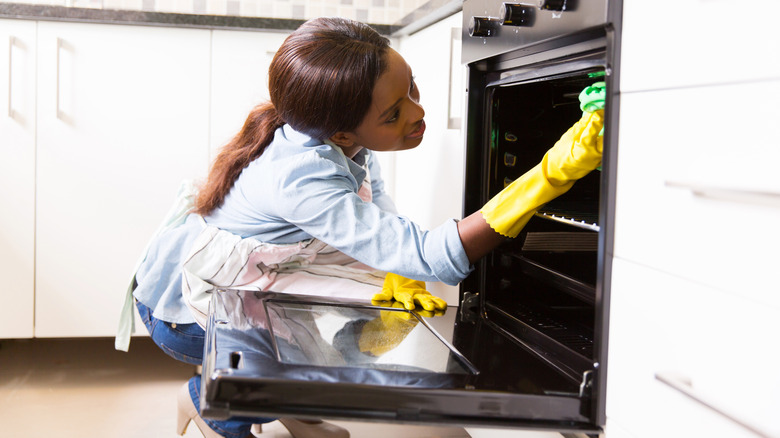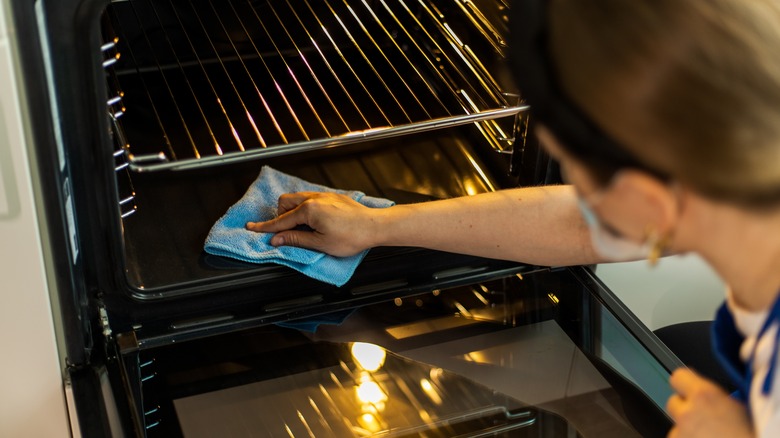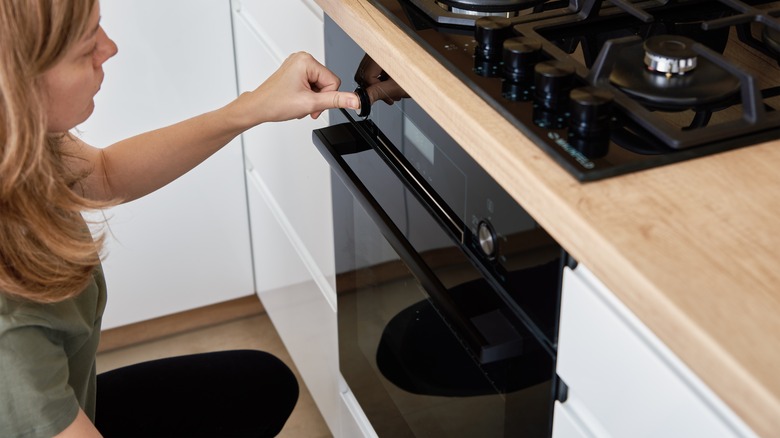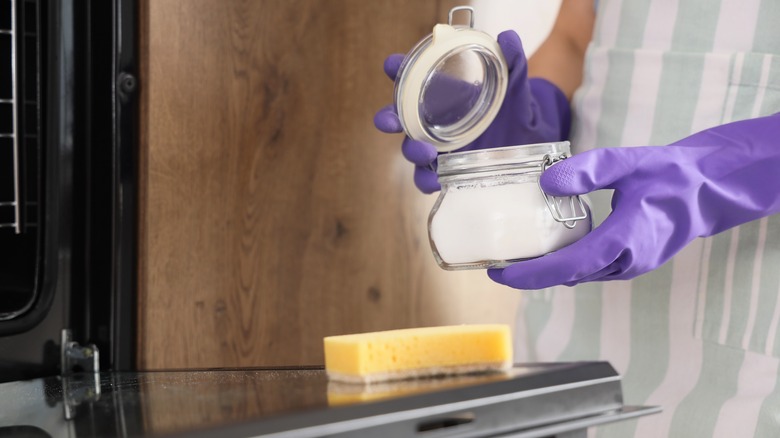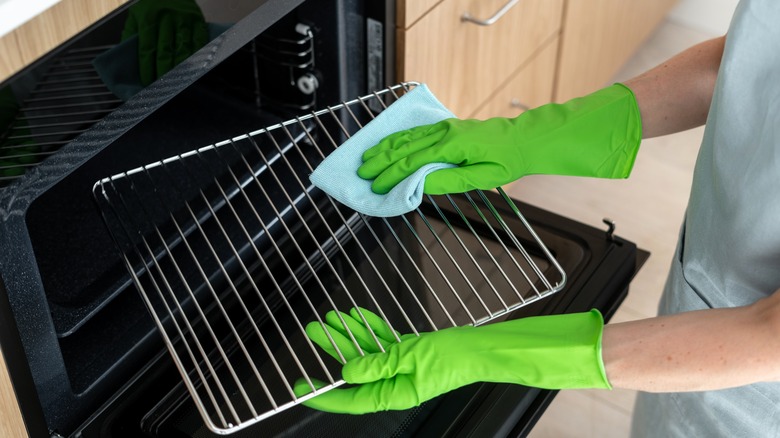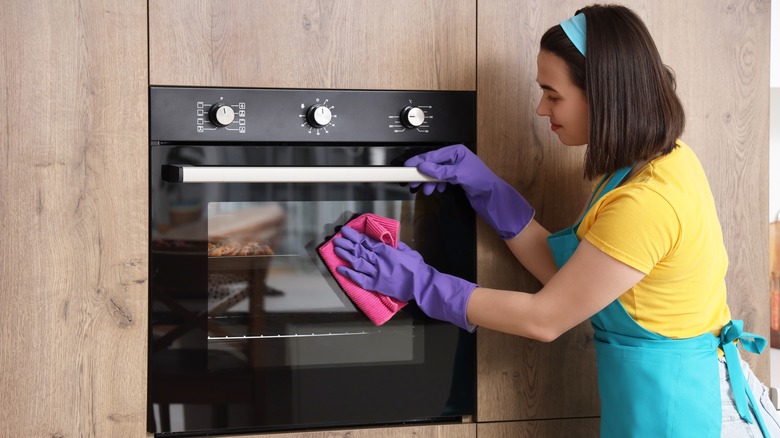The Top 5 Ways To Use Vinegar To Clean Your Oven For Sparkling Results
Sometimes, the dream of nontoxic, natural cleaners might have more to do with our devotion to them than their actual effectiveness. Not so with vinegar, though. There's plenty of solid research showing that vinegar is effective as a cleaner that can destroy pathogens like salmonella, E. coli, listeria, and even tuberculosis, leprosy, and antibiotic-resistant strains of staph and E. coli like MRSA. Vinegar is the real deal, and there might not be a better place to use its powers than your oven.
Through a mind-numbing sequence of chemical reactions, yeast converts sugars to alcohol, and a variety of bacteria from the genus Acetobacter and others can be used to convert alcohol to vinegar. The result has a ton of health and industrial uses, and it can be used around the home for everything from DIY weed killers to safe bee-repellent — a reason you can buy it by the gallon in any grocery store: its effectiveness at cleaning. Just keep in mind that it's not a foolproof disinfectant. Use it as a daily cleaner, but turn to products like bleach and alcohol when killing bacteria and viruses is critical.
Apple cider vinegar as a general-purpose surface cleaner
A 50/50 mixture of 5% distilled white vinegar and water is a great general-purpose surface cleaner, and there are many commercially available products that are little more than elaborate versions of this mixture. Largely by virtue of the acetic acid it contains, vinegar is excellent at breaking up surface stains and killing bacteria. Of course, working with cleaning vinegar (which can be as much as six times as strong as ordinary household white vinegar) means you'll either have to dilute it more to reach that 2.5% target or dilute it less if the strength is what you're after.
Lots of pros recommend cleaning ovens with apple cider vinegar combined with sugar, but few offer any explanation beyond the fact that sugar can be used as a crystalline abrasive. Many sources note that the addition of sugar makes apple cider vinegar better at softening grime. One clue to sugar's effectiveness might be in the vinegar itself. Apple cider vinegar is slightly less acidic than household white distilled vinegar (5%). Since vinegar's acidity is its most-mentioned asset in cleaning, it seems like this would make apple cider vinegar a worse cleaner. Perhaps the live cultures of fermentation bacteria in raw apple cider vinegar, which can feed on sugars, are encouraged to multiply and somehow break down the food materials that makeup oven grime. At a minimum, feeding them sugar would tend to increase the acetic acid that gives vinegar its cleaning oomph. Of course, diluting it with water erases any such benefit.
Steam-cleaning with vinegar
Vinegar really is the simplest and perhaps the most intuitive way to get your oven sparkling clean naturally and with minimal effort. All that's involved is adding vinegar and water in roughly 50/50 proportions to an oven-safe bowl or dish. Preheat your oven to its highest setting, usually around 500 degrees Fahrenheit. Add the bowl with the vinegar solution to the oven for up to one hour. Allow the oven to cool completely, then wipe it down with a dry microfiber cloth to remove the loosened grime.
Scrubbing and steaming your oven with vinegar has one little-known benefit – the ability to remove certain offensive odors produced by cooking. This is especially true of smells produced when preparing fish. These fishy odors are produced by a chemical called trimethylamine (TMA), which vinegar is very good at neutralizing. While steaming with vinegar is effective, some find the lingering scent of vinegar almost as objectionable as the smell of fish, so cleaning the oven surfaces directly with a vinegar solution might be a better solution for you.
Deep-clean with baking soda and vinegar
The classic oven cleaning method has to be the volcanic combination of vinegar and baking soda. However, many people do not know the correct method of using it. Too often, cleaners use baking soda and vinegar together from the beginning, which effectively neutralizes the acidic and alkaline qualities of the two chemicals from the outset. Instead, make a paste of water and baking soda, spread it over the entire surface of the oven interior, and let it soak overnight.
Wipe down the oven, then spray vinegar onto all the surfaces. You'll get some of that science-fair foaming action, which reportedly has some effect on harder-to-remove grime. Finally, wipe clean with a rag dampened with water. You'll see a paste of baking soda and vinegar used to clean just about everything, including most parts of ovens. And it definitely works, but it's better as a short-term cleaning agent than a soak.
Clean your oven racks
Cleaning your oven racks is always an adventure. The actual cleaning isn't necessarily any more difficult than any other oven-cleaning task. And — surprise! — a paste of vinegar and baking soda does an admirable job with the grates. You can add kosher salt as an abrasive and resort to adding a squirt of dish soap if you need more degreasing power. The trouble is what an enormous pain it is to properly cover, soak, clean, and rinse something that's about 90% air by volume.
There are a couple of approaches to working the cleaning solution in that you can borrow for the vinegar and baking soda method. The most obvious approach might be to start by soaking your racks in water, and the easiest way to get there might be using your bathtub. (But, make no mistake about it; you're adding a good tub cleaning to your chore list.) Alternatively, you can also put the racks in a large garbage bag.
Clean the oven's glass windows
Removing gunk from an oven's window is, of course, a two-part process: dealing with the outside of the glass and dealing with the inside. The outside tends to be a little less grimy, as you'd expect, and spraying straight 5% vinegar onto the glass and immediately wiping it clean is usually enough to make things clear again. You can apply the usual baking soda and water paste for a little more cleaning muscle to deal with nasty spills or buildup.
Cleaning the inside of the oven glass works the same way but in the opposite order. Since you can expect worse, baked-on grime, begin with the baking soda paste. Leave it in place for 20 to 30 minutes, then wipe the window clean with a microfiber cloth damp with warm water. If necessary, you can also spray a 1:1 vinegar/water mixture on the paste just before wiping the glass down, which might loosen the more stubborn stuff. Once the paste is removed, spray the same 50/50 mixture on the glass and wipe clean, just as you would with any glass cleaner.
